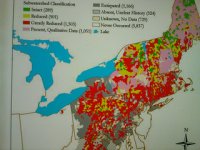T
troutbert
Well-known member
- Joined
- Nov 2, 2006
- Messages
- 10,768
What do you all estimate the current brook trout population in PA is, as a percentage of the original brook trout population, i.e. pre-European settlement?
Of course there is no way to know this exactly, but just what would be your rough estimate? (I will give my own ideas later, after hearing from others.)
Of course there is no way to know this exactly, but just what would be your rough estimate? (I will give my own ideas later, after hearing from others.)





